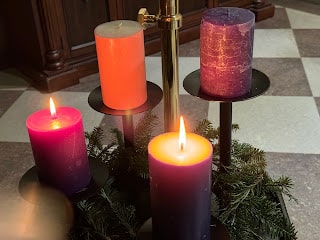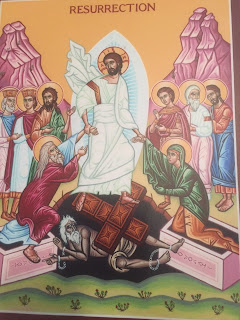Late last month, like so many other Americans I traveled across the country to spend Thanksgiving with my sister, her family, and their friends. On Thanksgiving night, after we had eaten our fill, some of us watched one of the classic movies of the 20th century, The Wizard of Oz. Famously, in that movie, the Good Witch wisely advised Dorothy “to begin at the beginning.”
That is exactly what the Church invites us to do today as it announces: The beginning of the gospel [that is, the “good news”] of Jesus Christ, the Son of God. It’s literally the title page of Mark’s Gospel, a title that tells us the central story of Christianity. Jesus is the Christ, the Messiah, God’s Anointed One. In Jesus, God himself has come among us. And it’s all good news.
All the more noteworthy, therefore, that the story doesn’t actually start with Jesus, but begins instead with John the Baptist, who appeared in the desert – almost, as it were, out of nowhere. From the harsh Judean desert, John the Baptist returns each Advent, as we hear his shrill voice shouting up and down the Jordan Valley: “Prepare the way of the Lord.” Every year at this Advent time, the Church takes John the Baptist out of storage, so to speak, to outshout the deafening din of our ordinary everyday noise and our holiday pandemonium, with his ancient and ever timely warning, “Prepare the way of the Lord, make straight his paths.”
For most of us, I suspect, John the Baptist seems a somewhat strange, mysteriously elusive figure. Having appeared, ever so briefly, as a kind of warm-up act at the beginning of Jesus’ public life. John then, when we’ve barely even gotten to know him, gets himself arrested – and is soon dead.
Were we today to encounter such an apparently odd-looking character, clothed in camel’s hair and eating locusts and wild honey, chances are that many – maybe most of us – might try to ignore him.
Fortunately, that did not happen the first time John’s jarring message was heard in the land. On the contrary, so we are told, the whole Judean countryside and all the inhabitants of Jerusalem were going out to him and were baptized by him in the Jordan River as they acknowledged their sins. What, one wonders, was it that they could see in John that we cynical, sophisticated moderns and post-moderns might be more tempted to ignore? Whatever it was that they saw, the point is that they listened and acted. They acknowledged their sins. So, when we hear him now, our task too is to listen – so as to act on what we hear.
One thing we do know that they saw in John – or rather hoped they were seeing, or perhaps feared they were seeing – was another prophet, another Elijah. When it comes to just how John the Baptist and Elijah are connected in the larger story, it helps to remember how the Jewish Bible and the Christian Old Testament differ in the way the biblical books are sequenced. The Jewish Bible, oriented to the present, concludes at the end of the second book of Chronicles with King Cyrus authorizing the Jews to return to Jerusalem and rebuild the Temple. The Christian Old Testament, oriented toward the future coming of Christ, concludes with the prophetic books and ends with these words of the prophet Malachi: Lo, I will send you Elijah, the prophet, before the day of the Lord comes, the great and terrible day, to turn the hearts of the fathers to their children, and the hearts of the children to their fathers, lest I come and strike the land with doom.
The key word in Malachi’s prophecy is, of course, lest – lest I come and strike the land with doom. Elijah’s assigned role is to make the day of the Lord not (what it would otherwise be) a day of doom, but a day of blessing. The gospels record elsewhere that Jesus himself saw in John the fulfillment of this prophecy. So, however shrill John may sound to our super sensitive ears, attuned as we are to very different kinds of marketing appeals, we need now to hear his call to repentance for the forgiveness of sins as an invitation to the true blessing that Christmas offers.
John’s mission, as clarified by the Gospel’s reference back to Isaiah’s prophecy, was about filling in valleys, leveling mountains and hills, and repairing whatever is rugged and rough – picturesque, ancient imagery that suggests not environmental catastrophe, but facing up to all those gaps and flaws and failings and sins in our personal lives, in our relationships, in our work, and in our world, and allowing God to lead us in fixing them. It’s a challenge we may be tempted to try to evade – but dare not, for as Isaiah says so pointedly: Here is your God.
Advent invites us to prepare the way of the Lord – not just as some abstract idea, detached and divorced from whatever else is going on in our lives right now, still less as just another item to be worked on in some ever-lengthening list of things to be done before Christmas. Rather, the point of Advent is to let the anniversary of Christ’s 1st coming concentrate our attention on his actual presence among us in the here and now and so prepare us for his final coming for which we say we wait in joyful hope. The challenge of Advent is to transform our anxious and fear–filled present that hopeful future promised by Christ’s 1st coming in the past.
Advent challenges us set aside our self-destructive sophistication and internalize John the Baptist’s invitation in every aspect of our lives and so bring John the Baptist’s message into the very heart of our society – through our participation in the community of the Church, a community acutely conscious of Christ’s coming and eager to share him and so remake our conflicted, anxiety-ridden world.
Homily for the Second Sunday of Advent, Saint Paul the Apostle Church, NY, December 10, 2023.





